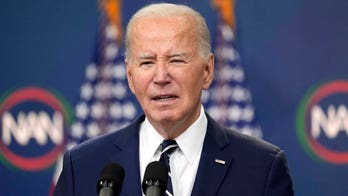Lawmakers said Tuesday they were considering doing more to monitor and hold accountable police departments across the United States that obtain sophisticated military equipment from the federal government.
The new scrutiny on Capitol Hill was prompted by weeks of violent conflicts between police in Ferguson, Missouri, and protesters upset about the fatal police shooting of an unarmed 18-year-old. Most military equipment, including some rifles and armored vehicles, is provided to local police under a program administered by the Homeland Security and Defense departments.
"These programs were established with a very good intention: to provide equipment that would help law enforcement perform their duties," said Sen. Tom Carper, D-Del., chairman of the Senate Homeland Security Committee. "The question is whether what our police receive matches what they truly need to uphold the law."
The White House had previously announced its own review of the police equipment program.
Sen. Claire McCaskill, D-Mo., said legislation may be the only way to make significant changes to the programs. She said she was concerned that much of the equipment being transferred from the Pentagon to police agencies was new gear that the Defense Department bought but never used.
"What in the world are we doing buying things we don't use?" McCaskill asked. "I guarantee the stuff you are giving away you are continuing to buy."
McCaskill and others also questioned the logic of supplying equipment originally intended for use by combat soldiers, including the multi-ton Mine-Resistant Ambush Protected vehicles, or MRAPS.
"How do they decide an MRAP is appropriate?" Sen. Tom Coburn, R-Okla., asked officials from Homeland Security, Defense and Justice departments. "It's not a truck. It is a ... offensive weapon."
Defense Undersecretary Alan Estevez told lawmakers that federal authorities rely on state coordinating officials to decide what equipment local agencies should receive and who will use it. He said all military equipment is stripped of most military tools, including .50-caliber guns on MRAPs, before the gear is passed on.
Training and how the gear is ultimately deployed is also largely left the states, Estevez said.
Grant money from the Federal Emergency Management Agency also allows police agencies to buy approved equipment, including armored vehicles and high-caliber weapons.
FEMA Assistant Administrator Brian Kamoie said military-style equipment bought by local and state police agencies helped deal with two terrorist-related incidents, including the Boston Marathon bombing.
He told Coburn that he was unaware that bombing suspect Dzhokhar Tsarnaev was found hiding in a boat by a Boston-area homeowner, not a helicopter with infrared equipment.
Equipment bought with FEMA grants is intended to be used strictly for anti-drug or terrorism-related incidents, but Sen. Rand Paul, R-Ky., said he worried that police departments are relying on such equipment to tamp down riots, like in Ferguson.
"They think these are for riot suppression," Paul said. "There's been maybe two instances of terrorism and we've spent billions and billions of dollars. Really (this gear) shouldn't be on anyone's list of authorized equipment."
Estevez said about $5.1 billion in military equipment has been given to local authorities since the transfer program started in 1990. Only about 4 percent of the gear has military attributes, including MRAPs and military-grade weapons.




